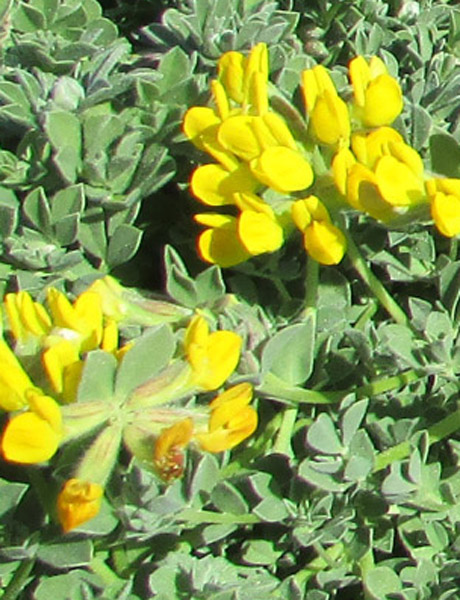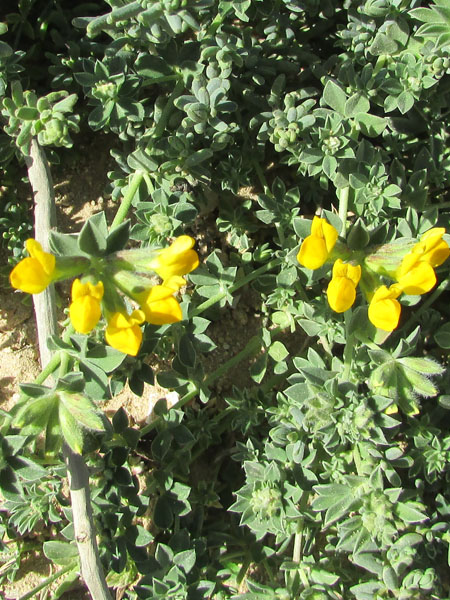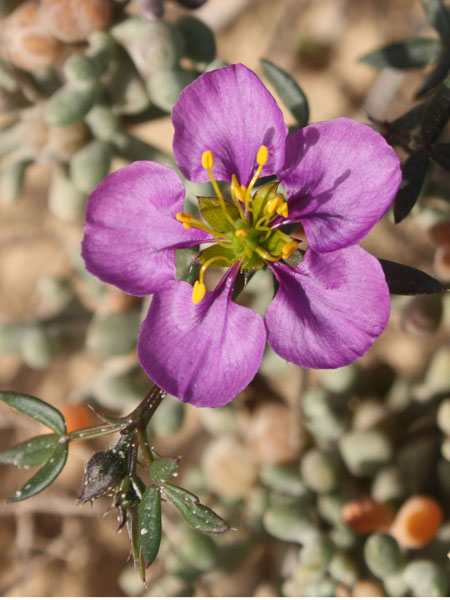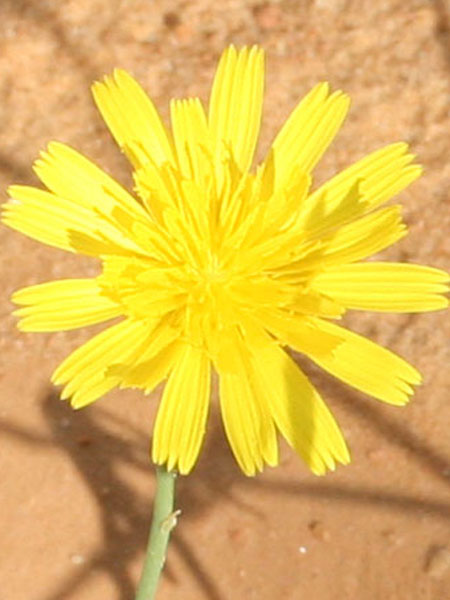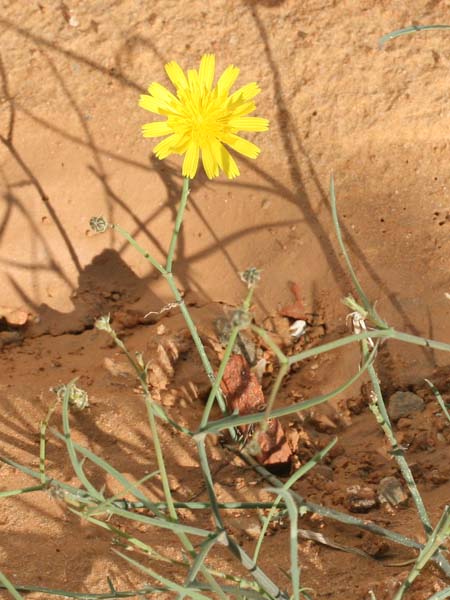Retama raetam
Kingdom : Plantae / النّباتات
Division : Spermaphyta / البذريات
Clade : Magnoliophyta or Angiospermae / مستورات البذور
Class : Eudicotyledoneae / ذات الفلقتين
Order : Fabales / رتبة الفُولِيَّات
Family : Fabaceae [Leguminosae] /البُقُولِيَّة أو القَرْنِيَّة أو الفَرَاشِيَّة أو القَطَانِيَّة أو الفُولِيَّة
Genus : Retama
species : raetam
Chromosomes: 2n=48
Protologue
(Forssk.) Webb in Webb & Berthel., Hist. Nat. Canaries 3 (2, 2):56 (1842)
Synonyms
Genista raetam
Forssk., Fl. Aegypt.-Arab., 214 (1775).Retama duriaei (Spach) Webb, Ann. Sci. Nat. Bot., sér. 2, 20: 279 (1843). Lygos raetam
(Forssk.) Heywood, Feddes Repert. 79: 53 (1968).
subsp. bovei (Spach) Talavera & Gibbs, Lagascalia 18: 271 (1996).Spartium bovei
Spach, Ann. Sci. Bot., sér. 2, 19: 297 (1843).Retama raetam var. duriaei (Spach) Letourn., Bull. Soc. Bot. Fr. 36:94 (1889). Retama monosperma subsp. bovei (Spach) Maire in Jahand. & Maire, Cat. Pl. Maroc 2: 357 (1932). subsp. raetam Retama raetam var. rigidula forma phaeocalyx (Webb) Maire, Fl. Afr. Nord 16: 197 (1987).
Common names
Tunisia Arabic English French Tamazight
رتم
الرّتم
White Broom
Telit
Toxic
yes
Edible
no
Latex
no
Botanic description
Genus description
"Calyx small, upper lip deeply tridentate. Monadelphous stamens. Bushy shrubs very ramous, with silky junciform branches, almost bare. Leaves linear, very deciduous, inferior 3-folate.
Species description
"Bushy shrub, smooth, broom-like, 50 to 1 m long, with many whitish erect stems.
Stems long junction-shaped branches, silky, almost bare, crenellated green and covered with small silky white hairs. The twigs turn yellow when aging. Leaves linear small on young twigs in winter and falling very fast in the hot season. Flowers white in clusters of 5 to 10 flowers, the calyx is purple. Fruits ovoid pod ending in a beak.
Botanic References
Pottier-Alapetite G. (1981). Flore de la Tunisie Angiospermes –Dicotylédones (Apétales- Dialypétale , Première partie). Imprimerie Officielle de la République Tunisienne (Eds), 308p. www.theplantlist.org
Biology
Life form Perennial Type form Hemicryptophyte Photosynthesis C3
Phenology
Blooming
JanuaryFebruaryMarchAprilMayJuneJulyAugustSeptemberOctoberNovemberDecember
Fruiting
JanuaryFebruaryMarchAprilMayJuneJulyAugustSeptemberOctoberNovemberDecember
Map Localization
Ecology
Adaptation Gypso-halophyte plant, excellent dune fixer. Deciduous foliage which allows the plant to resist drought because it offers little surface for evaporation. Salt bladder yes Invasive no
Geographical distribution
Localization Biocimatic stage Annuel pluviometry (mm) GPS Monastir (Skanès, Juillet 2016) Inferior semi-arid 331 35°46'41.92"N / 10°47'38.91"E Cap Bon (Korba, Mars 2014) Superior semi-arid 444 36°34'58.91"N / 10°52'5.60"E Bizerte (Rimel, Déc. 2014) Lower humid - sub-humid 653 37°15'27.31"N / 9°54'11.59"E
General uses
Medicinal uses
"It is also effective against diuretic and antiviral anemia. The black honey extracted from the plant is a good remedy against several microbes.
NOTE : This website is not that of herbal medicine and assumes no responsibility for the negative effects of the use of plants. Seek advice from a professional before using a medicinal plant.
Systems / Organs / Effects
Reproductive System Nervous System Urinary System Respiratory System Eays Analgesic Antiinflammatory Skin
Test results
TPC DPPH ABTS+ FRAP Year mg GAE g-1 MS CI50 g ml-1 CI50 g ml-1 CE50 g ml-1 30,37± 4,03 134,13± 0,69 254,75± 1,35 672,93± 50,63 2016 Total Phenols content(TPC), Anti-radical potentialities against (DPPH, ABTS), Ferric reducing antioxidant power(FRAP)
Molecules : ADN / Proteins
Chromosomes : 48 Uniprot NCBI
Chemical composition
Name Phenolic compounds 3'-O-methylorobol link
Coumarine link
Flavones link
Quercetine link
Vitexin
Vicenin
Genistin
7-Di-O-b-glucosideles
Resorcinol link
(+)-hydrate -catechin link
Rhamnoside link
Naringin link
Luteolin link
3,4-dihydroxybenzoic acid link
Phenolic acids Cafeic acid link
Ferrulic acid link
Gallic acid link
Rosmarinic acid link
Syringic acid link
Vallinic acid link
Transcinnamic acid
p-coumaric acid link
o-coumaric acid link
Salicylic acid link
Carnosic acid link
Trans-hydroxycinnamic acid
Other compouds Pectin
Tunisian references
Boukef M.K. (1986). Les plantes dans la médecine traditionnelle tunisienne. Médecine traditionnelle et pharmacopée. Librairie Larose (Eds), paris, 350p. Edziri H, Mastouri M, ChéraifI and Aouini M. (2010). Chemical composition and antibacterial, antifungal and antioxidant activities of the flower oil of Retama raetam (Forssk.) Webb from Tunisia, Nat. Prod. Res. 24, 789-796. Hayet E, Samia A, Patrick G, Ali M, Maha M, Laurent G, Mighri Z and Mahjoub L. (2007). Antimicrobial and cytotoxic activity of Marrubium alysson and Retama raetam grown in Tunisia, Pakistan J. Biol. Sci. 10, 1759-62. Hayet E, Maha M, Samia A, Mata M, Gros P, Raida H, Ali M, Mohamed AS, Gutmann L, Mighri Z and Mahjoub A. (2008). Antimicrobial, antioxidant, and antiviral activities of Retama raetam (Forssk.) Webb flowers growing in Tunisia, World J. Microbiol. Biotech. 24, 2933-40. Saada M, Falleh H, Jalleli I, Snoussi M, Ksouri R. (2014). Phenolic profile, biological activities and fraction analysis of the medicinal halophyte Retama raetam. South African Journal of Botany.94 :114–121
Other references
Abdalla MF and Saleh NAM(1983). Flavonoids of Retama raetam, J. Nat. Prod. 46, 757-757. Algandaby MM, Alghamdi HA, Ashour OM, Abdel-Naim AB, Ghareib SA, AbdelSattar EA and Hajar AS. (2010). Mechanisms of the antihyperglycemic activity of Retama raetam in streptozotocin-induced diabetic rats, Food Chem. Toxicol. 48, 2448-2453. Djeddi S, Karioti A, Yannakopoulou E, Papadopoulos K, Chatter R, Skaltsa H. (2013). Analgesic and Antioxidant Activities of Algerian Retama raetam (Forssk.) Webb & Berthel Extracts Rec. Nat. Prod. 7:3 169-176. Eddouks M, Maghrani M, Louedec L, Halouji M and Michel JB. (2007). Antihypertensive activity of the aqueous extract of Retama raetam (Forssk.) leaves in spontaneously hypertensive rats, J. Herbal Pharmacotherapy . 7, 65-77. Kassem M, Morsharrafan SA, Saleh NAM and Abdel-Wahab SM. (2000). Two new flavonoids from Retama raetam, Fitoter. 71, 649-654. Maghrani M, Zeggwagh NA, Haloui M and Eddouks M. (2005). Acute diuretic effect of aqueous extract of Retama raetam in normal rats, J. Ethnopharm. 99, 31.





















